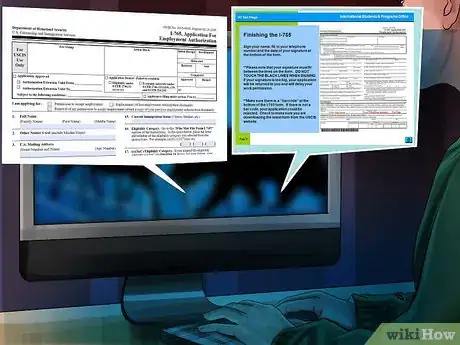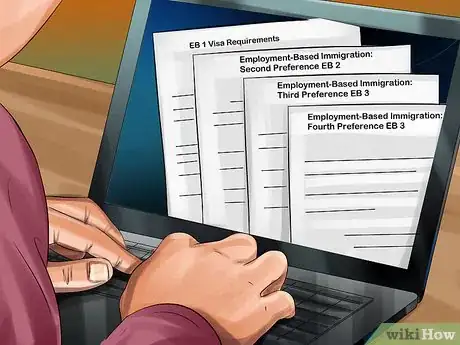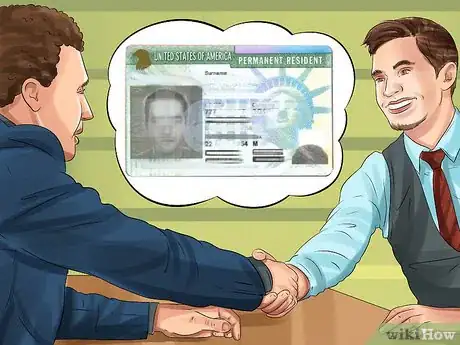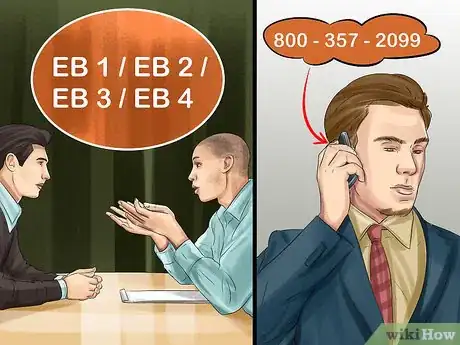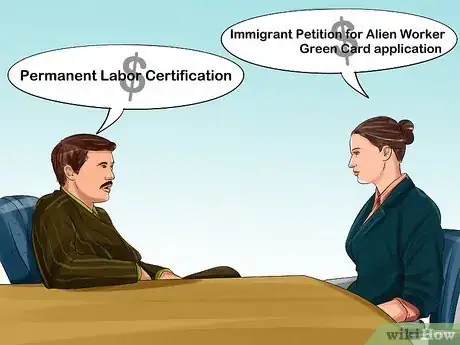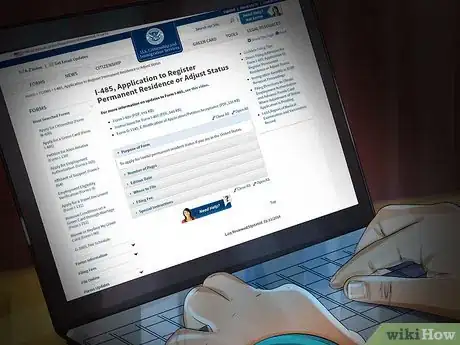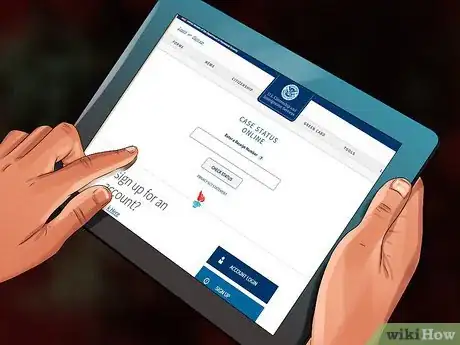This article was co-authored by Valery Cury and by wikiHow staff writer, Megaera Lorenz, PhD. Valery Cury is an Immigration Attorney based in Santa Ana, California. With over seven years of experience, she specializes in affirmative cases. Valery earned her Master’s Degree from Brooklyn Law School and her Bachelor’s Degree in Law from Pontificia Universidad Catolica Madre y Maestra in the Dominican Republic. She is licensed to practice in the State of Connecticut. She’s also a member of the American Immigration Lawyers Association (AILA) and the Dominican Bar Association (DBA).
There are 17 references cited in this article, which can be found at the bottom of the page.
This article has been viewed 58,258 times.
A Green Card, or Permanent Resident Card, is a document that allows foreign nationals to live and work permanently in the US. Getting an employment-based Green Card can be tricky, however, since it costs money and takes time for your employer to arrange. Improve your chances by first making sure that you are already eligible to apply for a Green Card. Have a conversation with your employer about your desire to get a Green Card, and discuss your options. Work with your employer to make sure you have all the documents you need to apply.
Steps
Confirming Your Green Card Eligibility
-
1Look into your employment authorization status. In order to get a Green Card, you will need to have permission to work in the US. If you are already living and authorized to work in the US (e.g., on an H-1B visa or with an Employment Authorization Document), then the Green Card application process will be easier.[1] If you do not have a visa or other form of approval to live and work in the US, you may have a long waiting period before you can get Green Card approval.[2]
- If you do not have permission to work in the US already, you have a variety of options. If you are in the US temporarily as a refugee, a student, or a non-permanent employee, you can submit an Application for Employment Authorization (form I-765).[3]
- There are also a variety of nonimmigrant visas available for people who want to work in the US temporarily. These visas can serve as stepping stones for starting the Green Card application process.[4]
-
2Check the eligibility categories for employment-based Green Cards. Before approaching an employer or potential employer about getting a Green Card, consider whether you belong to one of these categories:[5]
- EB-1, or “first preference”: Workers with exceptional skills in the arts, sciences, education, business, or athletics, including researchers, professors, and multinational managers or business executives.
- EB-2, or “second preference”: Workers in professions that require an advanced degree, people who are highly skilled in the sciences, arts, or business (e.g., with more than 10 years of experience and evidence of exceptional abilities or contributions in their field), and workers applying for a national interest waiver.
- EB-3, or “third preference”: Skilled workers (people with 2+ years of training or work experience), professionals (people with a bachelor’s degree or equivalent in their profession), and unskilled workers (for labor requiring less than 2 years of experience or training, e.g., manual labor in factory settings, or certain types of agricultural work).
- EB-4, or “fourth preference”: Immigrants with special status (e.g., religious workers, certain physicians, broadcasters, and other special categories).[6]
Advertisement -
3Find out if there is anything that might make you ineligible. In addition to your skills and credentials, there are other factors that may affect your ability to get a Green Card or work in the US.[7] You may have trouble getting a Green Card or be ineligible to get a Green Card if you:[8]
- Have a health condition that is potentially a threat to others, such as a communicable disease, or a mental disorder that may cause you to behave in ways that threaten yourself or others.
- Have a criminal record in the United States or another country.
- Have ties to organizations that are considered hostile to US interests, such as known terrorist organizations or totalitarian political parties.
- Entered the US illegally or have been working in the US without permission.[9]
Approaching Your Employer about Sponsorship
-
1Be honest about your work eligibility when you apply. Many jobs require applicants to specify whether they are eligible to work in the US. If your potential employer asks you whether you will need sponsorship to work in the US now or in the future, answer honestly. If they are willing to interview you or make a job offer with that information in mind, chances are they will be willing to consider sponsoring you for a Green Card.
- Employers in the US are not legally allowed to ask you if you are a US citizen, and they cannot ask about your national origin. They can only ask if you are currently authorized to work in the US, and if you may need sponsorship in the future.[10]
- You are not legally required to prove your eligibility to work in the US unless you are offered a job.[11]
-
2Discuss Green Card sponsorship after you get a job offer. If you have gotten as far as receiving a job offer, then your employer is clearly very interested in working with you and is likely already aware of your immigrant status. This is a good time to bring up the issue of Green Card sponsorship.
- For example, if you have just received a job offer, you might say something like, “I am very interested in this opportunity and would like to accept your offer. Before we go forward, can we discuss the steps we need to take together to help me get authorization to work permanently in the US?”
-
3Ask your employer about their Green Card policy. There is no consistent policy from one employer to another regarding Green Card sponsorship. Your employer’s willingness to sponsor you may depend on a variety of factors, such as how big the company is, which eligibility category you fall into, whether or not you already have permission to work in the US, and whether you are a potential hire or a current employee.[12]
- Some employers may have an immigration lawyer on staff to make the process easier.
- Some employers might start the process of sponsoring you for a Green Card immediately at the time that you are hired, while others may expect you to spend some time with the company on a work visa first.
-
4Talk to your employer about your eligibility. The process for getting your Green Card depends on which eligibility category you fall into (EB-1, EB-2, EB-3, or other). Your employer will not need to file as much paperwork if you are an EB-1 (“first preference”) worker as they would for other categories.[13] Let your employer know if you already have an immigration or work visa.
- Your employer can call the US Citizenship and Immigration Services office at 1-800-357-2099 to get more information about permanent employment eligibility categories for immigrants.
-
5Find out if your employer expects you to cover any expenses. The Green Card filing process can be very expensive for both you and your employer. While your employer is required to cover some of the costs (e.g., for obtaining your Permanent Labor Certification), they may expect you to cover some or all of the other required fees for obtaining your Green Card. Sit down with your employer ahead of time and come up with a formal agreement about who will be responsible for which expenses.
- Your employer may hold you responsible for the I-140 (Immigrant Petition for Alien Worker) and I-485 (Green Card application) filing fees. If you are applying for just yourself, these fees may total around $1,925. Additional fees may apply if you are seeking Green Cards for dependents or relatives.
- Some employers may charge employees for attorneys’ fees associated with the Green Card filing process.
Gathering the Appropriate Documents
-
1Find out if you need an Application for Permanent Labor Certification. Most categories of immigrant employees will need a Permanent Labor Certification before they can apply for a Green Card. If you are an EB-1 worker or an EB-2 worker who qualifies for a national interest waiver, your employer will not need to file for a Permanent Labor Certification for you.[14]
- Your employer is responsible for submitting the application and paying all application fees for your Permanent Labor Certification.
- The process of filing for Permanent Labor Certification is complex, and it may take several months to complete.[15] Your employer can check the status of the application here: https://icert.doleta.gov/
-
2Ask your employer to file an I-140 form for you. After your employer obtains a Permanent Labor Certification for you (if applicable), the next step is for them to file an I-140 (Immigrant Petition for Alien Worker) form on your behalf. Depending on your circumstances, you may need to get your I-140 petition approved before you can apply for a Green Card. If there is no wait time for you to get your immigration visa, you can file your I-485 (Green Card application) and I-140 form at the same time.[16]
- Work with your employer to ensure they have all the information they need to fill out the I-140 correctly (including your full name, country of citizenship and country of nationality, mailing address, Alien Registration Number, passport number, and I-94 Arrival-Departure Record Number).
- If you have any family members or dependents who will be immigrating with you, your employer will need to provide information about them on the I-140 as well.
- If you fall under a special immigrant category (e.g., if you are a religious worker, a Canal Zone employee, or a physician working under certain circumstances), your employer will need to file an I-360 form (Petition for Amerasian, Widow(er), or Special Immigrant) instead.
- I-140 processing time typically takes several months. However, most categories of immigrant workers can qualify for premium processing, which guarantees a processing time of 15 days. Premium processing requires an additional filing fee of $1,225 and the completion of an I-907 form.[17]
-
3File a Form I-485 if you are already in the US. It is your responsibility to file the I-485 (Application to Register Permanent Residence). You must be physically present in the US and have an immigrant visa available to you immediately in order to file the I-485.[18] The form is available for free from the USCIS website here: https://www.uscis.gov/i-485
- Where you file the form will depend on your individual circumstances. Check the USCIS Direct Filing Addresses page here: https://www.uscis.gov/i-485-addresses
- The typical filing fee for employment-based applicants is $1,225 USD.[19] Some employers may be willing to pay some or all of this fee for you.
- The wait time for getting your I-485 approved may vary depending on your immigrant status and which office is handling your case. If you are in the US and have paid your immigrant visa fee, processing time may take up to 120 days from the time of entry or the time of paying the fee.
-
4Submit any other applicable documents. You will need to submit various documents along with your I-485 in order to support your application. These will vary depending on your circumstances and eligibility category, but may include:[20]
- 2 passport-style color photos of yourself.
- A photocopy of a government-issued ID with a photograph (e.g., your passport).
- A photocopy of your birth certificate, or proof that no birth certificate is available.
- Copies of documents certifying that you were inspected by an immigration officer and admitted into the US.
- Documentation of your immigrant category.
- A copy of an official job offer from your employer.
- A form completed by a USCIS civil surgeon certifying that you do not have any medical conditions that would prevent you from being eligible to live in the US.
-
5Check the status of your application. Once you’ve submitted all of the appropriate fees and paperwork, you can check the status of your application online. Keep your filing receipts, as you will need the receipt number to look up your case. Check your status here: https://egov.uscis.gov/casestatus/landing.do
-
6File an appeal if your application is denied. If your application for a Green Card is denied, you may be able to submit an appeal to the USCIS Administrative Appeals Office (AAO). An appeal must be filed within 30 days of an unfavorable decision.[21]
- To appeal, file a form I-290B (Notice of Appeal or Motion). In most cases, you will need to submit a $675 filing fee.[22]
Community Q&A
-
QuestionCan an employer who is sponsoring an employee for a green card draft a legal document to prevent the employee from leaving the company?
 Community AnswerYes, an employer can legally require an employee to stay with the company for a pre-determined amount of time if they are sponsoring said employee for a green card.
Community AnswerYes, an employer can legally require an employee to stay with the company for a pre-determined amount of time if they are sponsoring said employee for a green card.
Expert Interview
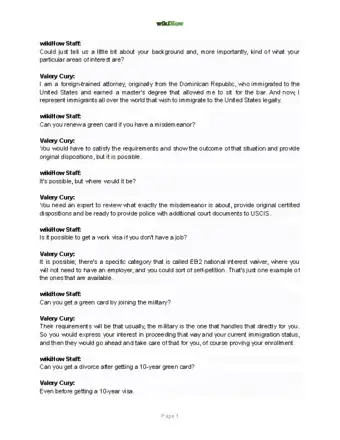
Thanks for reading our article! If you'd like to learn more about getting a green card, check out our in-depth interview with Valery Cury.
References
- ↑ https://www.uscis.gov/greencard/consular-processing
- ↑ https://www.uscis.gov/sites/default/files/USCIS/Resources/E2en.pdf
- ↑ https://www.uscis.gov/i-765
- ↑ https://www.uscis.gov/working-united-states/working-us
- ↑ https://www.uscis.gov/greencard/eligibility-categories
- ↑ https://www.uscis.gov/working-united-states/permanent-workers/employment-based-immigration-fourth-preference-eb-4
- ↑ https://www.uscis.gov/green-card/employment-based
- ↑ https://www.uscis.gov/ilink/docView/SLB/HTML/SLB/0-0-0-1/0-0-0-29/0-0-0-2006.html#0-0-0-202
- ↑ https://www.uscis.gov/ilink/docView/SLB/HTML/SLB/0-0-0-1/0-0-0-29/0-0-0-7418.html#0-0-0-274
- ↑ https://www.eeoc.gov/laws/practices/inquiries_citizenship.cfm
- ↑ https://www.eeoc.gov/laws/practices/inquiries_citizenship.cfm
- ↑ https://www.inc.com/alex-moazed/green-card-sponsorship-policy-does-your-company-have-one.html
- ↑ https://www.uscis.gov/sites/default/files/USCIS/Resources/E2en.pdf
- ↑ https://www.uscis.gov/sites/default/files/USCIS/Resources/E2en.pdf
- ↑ https://www.foreignlaborcert.doleta.gov/qa.cfm
- ↑ https://www.uscis.gov/green-card/employment-based
- ↑ https://www.uscis.gov/i-907
- ↑ https://www.uscis.gov/green-card/employment-based
- ↑ https://www.uscis.gov/i-485
- ↑ https://www.uscis.gov/i-485
- ↑ https://www.uscis.gov/forms/questions-and-answers-appeals-and-motions
- ↑ https://www.uscis.gov/i-290b
- ↑ https://www.uscis.gov/working-united-states/permanent-workers/employment-based-immigration-second-preference-eb-2
About This Article
If you’re applying for a job in the U.S. as a foreign national, you’ll need your employer to sponsor your green card before you can start working. It’s important to be upfront about your immigration status during interviews so your employer will be more likely to help you if they offer you a job. Let your employer know if you already have an immigration or work visa. Once you get a job offer, ask your employer about their green card policy and if they’re willing to sponsor you. You should also ask if they expect you to cover some or all of the required fees for obtaining your green card, so you can get your finances in order. For more tips, including which documents you need to apply for your green card, read on!
